Every business that invests in SEO wants to increase its online visibility. That is the only reason professional marketers advise their clients to invest heavily in keyword research.
Content creators and digital marketers focus more on high search volume keywords because they believe they offer the highest traffic and conversion rates.
That sounds true to most e-commerce websites. However, there is some sugar hidden in low search volume keywords. You can still get traffic and customers by using low-search volume keywords in your SEO strategy.
This article shows how you can maximise your SEO investment with low-search volume keywords. Stay put into learning to use low-search keywords and still get the customers and traffic you want.
What is the Keyword Search Volume?
Keyword search volume refers to the number of times a particular keyword is searched over a specific period.
Expert marketers use the keyword search volume metric to measure the traffic a keyword is likely to generate to a website when you use it in your content.
Keyword search volume also shows the competitiveness of a search term.
You can find the keyword search volume using SEO keyword research tools such as SEMrush, Ahrefs, Spyfu, or Wordstream.
You can also use the Google Keyword Planner to research the best keywords to target.
I will take the example of SEMrush to find the best low-search volume keywords for my business.
For instance, I have a website selling travel insurance. I will go to SEMrush and enter the primary keyword ‘travel insurance’ in the search bar.
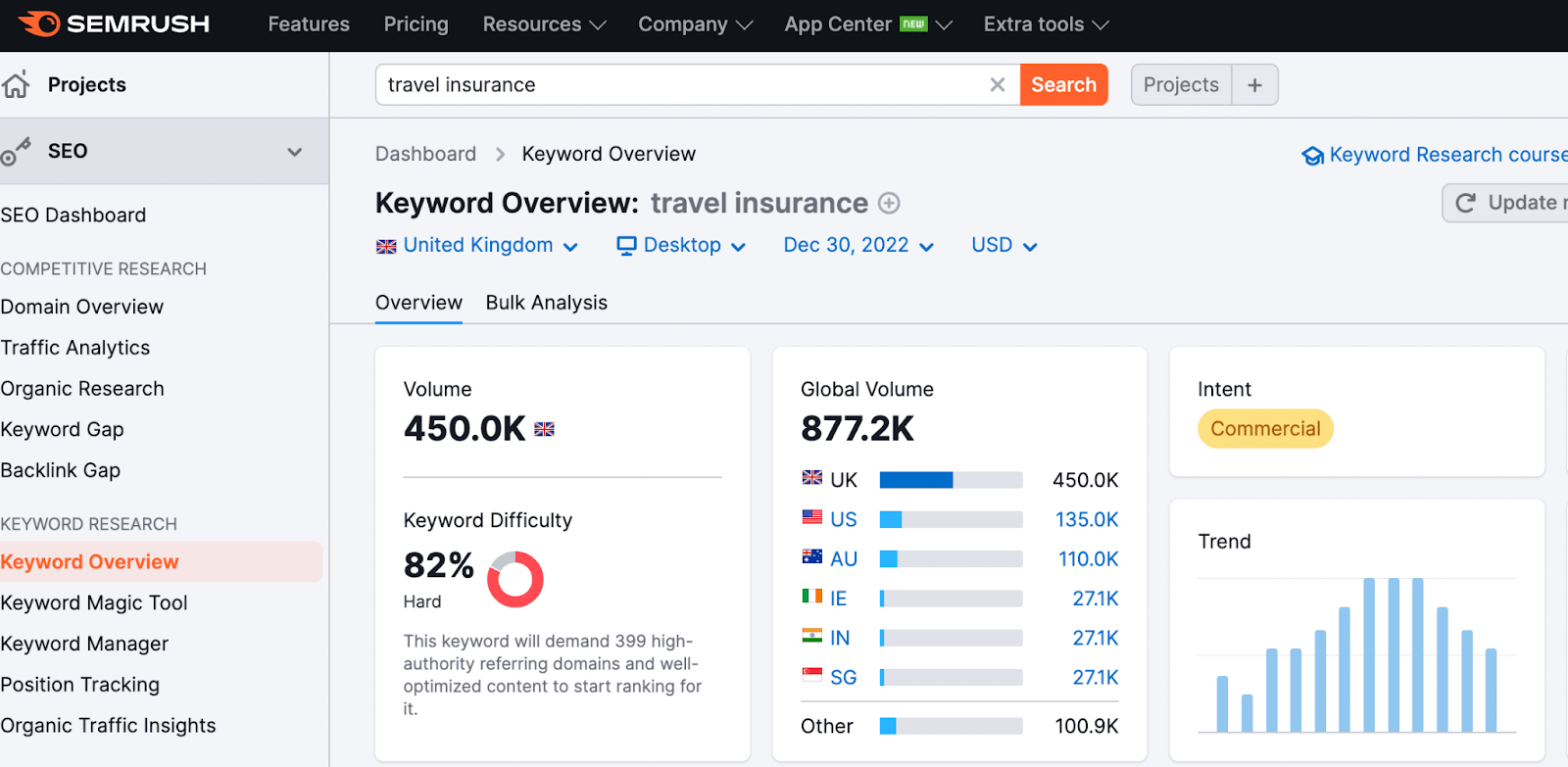
The tool will return a list of top keywords to target.
The keyword list is divided into three categories, namely “keyword variations,” “questions,” and “related keywords.”
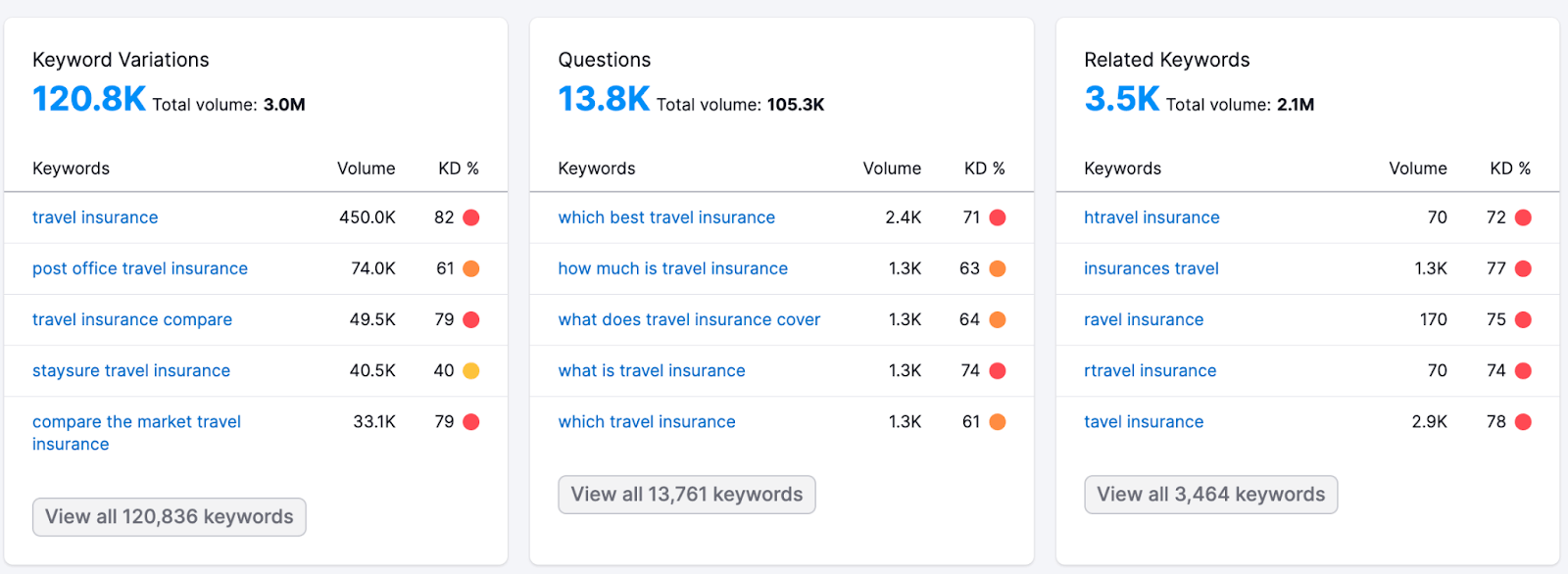
I will browse through every list and pick keywords with a low keyword difficulty score and low search volume. This will help me get the top page rankings faster.
What are Low Search Volume Keywords?
A low search volume keyword is a search term with a small search volume.
In other words, it’s a status given to keywords that don’t have enough search volume, meaning, targeting such keywords will result in low impressions and clicks.
Low search volume keywords are often targeted by new websites because they are easier to rank for.
While you may not see a sudden increase in the number of visits to your site, you can definitely raise your organic traffic to some extent.
Besides, the best advantage you get with low-volume keywords is that whatever traffic your website attracts, they have a high chance of a conversion.
6 Reasons Why You Should Target Low Search Keywords
Low search volume keywords are not as useless as most people may think. There are many accounts in which using low-search keywords will be more beneficial to your website and brand marketing.
Here are some of the cases where you should look forward to using low-volume keywords:
1- When the user intent is high
You should target a low search volume keyword with higher user intent.
User intent refers to why a user searches for a specific search term on Google.
For example, when a customer searches for “best marketing agency” versus “marketing agency,” the two search queries have different user intent.
If someone is searching for the best marketing agency, they are probably looking for a review of the best marketing agencies in their location.
If you enter this search term on Google, you will likely get more reviews on the search results.
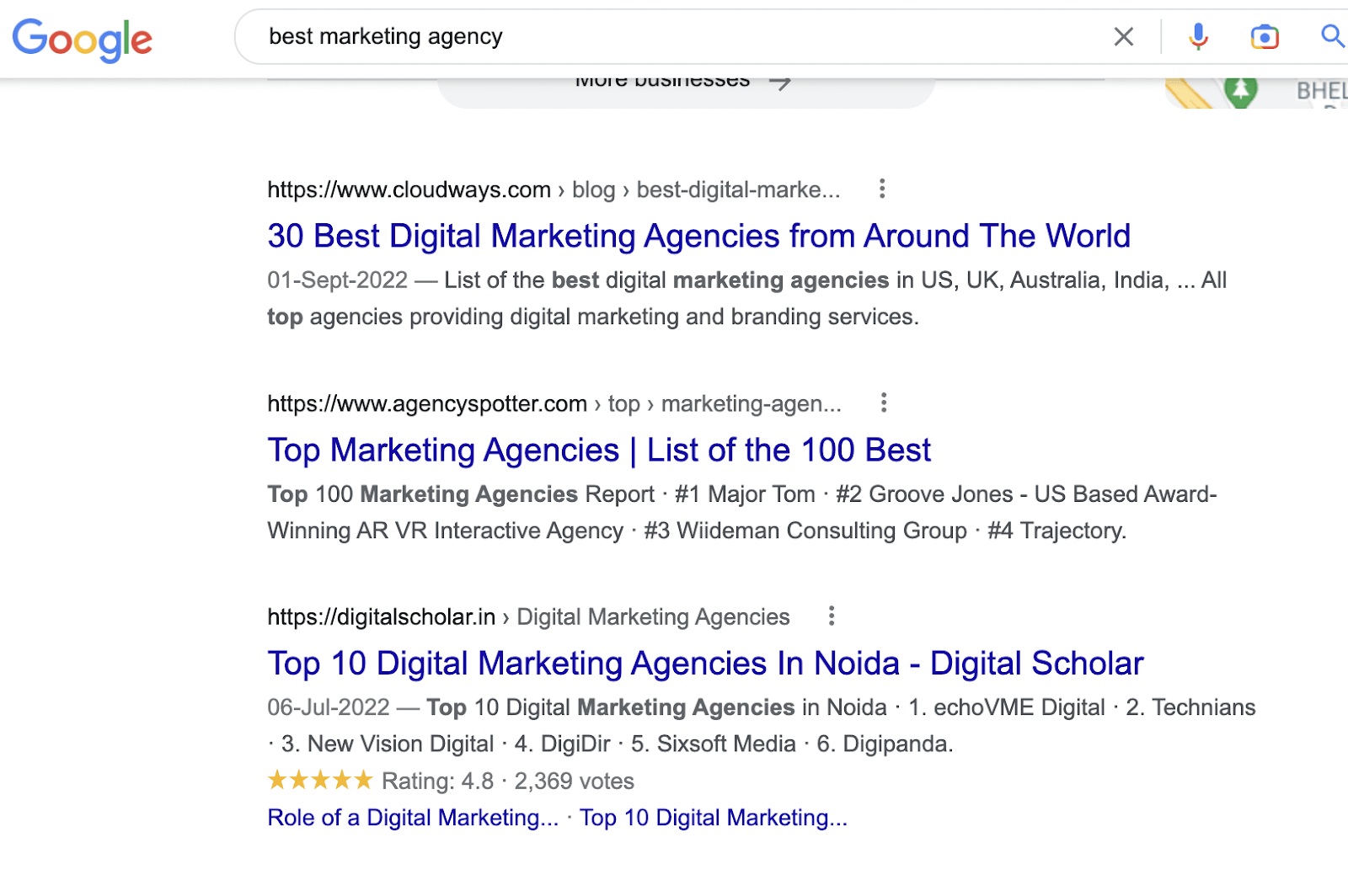
Alternatively, when users are searching for a marketing agency, Google results show more of where to get the service.
What does this scenario refer to? It means the keyword “best marketing agency” is information based.
Whoever enters the search query has not yet decided to hire a marketing agency but is seeking knowledge on the best marketing agencies.
The other keyword, ‘marketing agency,’ shows that the user is looking to hire a marketing agency. This is why Google is offering marketing agencies in the search results.
In this scenario, if you wish to get your marketing agency listed at the top of the ‘best marketing agency’ list, you can target this keyword and create a listicle listing your company at the top.
This way, you would be able to reach new customers at the top of the sales funnel when users are looking to make their choices.
Thereafter, when they find your company listed at the top, they can do a direct search on Google with your company and choose your service. Besides, you don’t have to spend heavily targeting a competitive keyword term, such as ‘marketing agency.’
2- When the search difficulty is low
The right time to focus on low search volume keywords is when the search difficulty is also low. Search difficulty is how difficult it would be for your site to rank on a given keyword.
Most digital marketers tend to focus more on low-search keywords because they are easier to rank fast without doing much work.
When a keyword has a high search volume and difficulty, it is more challenging to rank. You need many backlinks and higher authority to get traffic from such keywords.
If you want your content to rank fast on Google, you should find the lowest competition keywords and include them naturally in your content.
When you do this, you spread your content over a wide variety of keywords and face low competition, which means you can rank quickly.
You will also get more traffic to your site and increase your domain authority as you can focus on higher search volume keywords with time.
3- When you want to cover a long-tail keyword
You can focus on using a low-search volume keyword when it’s a long-tail keyword with relevant search intent.
A long tail keyword is a search phrase containing more than four words. The keywords usually have low search volume but are more specific.
For example, a long tail keyword like” what is the best boxing gear for beginner boxers” may have a low search volume per month, and the keyword “best boxing gear’ may have a higher search volume per month.
Both keywords are useful for a boxing gear website. However, the long tail keyword is easier to rank for compared to the high search volume keyword.
When launching a new website, you should start by using low-search volume keywords. You can also target high-search volume and low-competition keywords.
4- You are covering a niche topic
You may have to cover a low search volume keyword because it belongs to your niche.
For instance, in the case of “the best boxing gear for beginners,” this may be a low search volume keyword overall. Most people are probably not looking for this keyword on search because it only caters to the boxing niche.
Those in the boxing industry want to find the best boxing gear in the market, and this is a relevant keyword for them.
For this reason, you should cover low search volume keywords even if they don’t drive a lot of traffic to your website. Remember, search engines focus more on the UX of websites and rewards sites that offer relevant content.
5- When it has a low Cost Per Click (CPC)
Cost per Click (CPC) is the average cost you pay as an advertiser to get people to click on your advert.
Most low-search volume keywords have a low CPC. For this reason, most digital advertisers focus on them. It would be easy to beat your competitors and find your website at the top of search results even when you get only ten people per month.
High search volume keywords are more competitive and cost a lot to get clicks. For instance, if you are targeting a keyword with a $3.00 CPC, you are likely to spend a lot of money to get clicks and rank on the first page.
The cost of having high search volume keywords in your content is high; that is why you should consider low search volume keywords if you are just starting a website.
The competition to get clicks for low search volume keywords is low, and the cost of getting people to click on your website is also low.
6- When you want to do link-building
Link building is a vital part of SEO. When starting a new website, you want to rank on search results. For that, you should focus on link building to drive more links from authority sites because links are one of the top ranking factors.
When you build links, you are simply acquiring votes for your domain from other sites related to your niche. More votes lead to higher domain authority and higher rankings.
To acquire links naturally, you need to publish lots of relevant content on your site so that it ranks on the search engines. People often link to sites that rank higher.
Hence, the more online visibility your web pages get in the search results, the higher the chances of acquiring links.
Here are the types of content that you should publish on your site based on low search volume keywords:
- Stats based articles
- Infographics
- Top 10 listicles
- Top trends to follow
- How-to based articles on long-tail question searches
If you expect link building to work in your favour, you should always produce original and high-quality content. When you write top-quality content, you prove to website owners that you deserve a space on their blog.
How to Find Low-Search Volume Keywords for SEO
Every website wants to rank at the top for high-search volume keywords. You want your business to get traffic, conversions, and sales from organic search.
However, not every business can rank for high-search volume keywords – the competition is stiff. It means many websites are competing for the first page of Google search results.
So, what do you do when you have a small website with a less authority domain?
Find some low-search volume keywords in your target niche.
Identify the low-competition keywords which have a better chance of ranking your website at the top and use them in your content.
There are four main ways to identify low search volume keywords to improve your website SEO and appear on organic search results.
1- Talk to the customer care team
The simplest and the most cost-effective way to get low search volume keywords is to talk to your customer support team.
You should ask the customer support team to share with you some of the questions your target customer is asking. Remember, the customer care team handles your customers more than anyone else.
The customer care team can offer some real-time and valuable insights on FAQs, issues, concerns, and positive feedback from your customers.
By talking to the customer support team, you can find out what information is missing on your website that you should add to rank.
Additionally, you can check the live chat logs and emails if you want to find out what questions your potential consumers are asking.
You can also use the mind mapping concept to gather keyword knowledge from your customers and the support team. For instance, you can begin with a topic like “Local SEO” and find the sub-topics that link back to it.
2- Use YouTube to pull out keywords ideas
Customers always use social media platforms like YouTube to interact and engage with brands.
With over 2.1 billion monthly active users on YouTube, you can be sure of getting some proper low-search volume keywords that you can use in your content for SEO.
Find out what people are searching for on YouTube that relates to your niche.
You can check out the different Q&As, how-to-videos, industry news, and tutorials your target audience is watching on YouTube to get more insights into your content strategy.
Additionally, when you go through the comment section on YouTube. In some instances, you can find more information on low search volume keywords in the comment section than the published videos on YouTube.
3- Take ideas from social media platforms
Most people go to social media when they want to tag and comment on a product or service.
Therefore, social media platforms like LinkedIn, Pinterest, Instagram, and Facebook are some places where you want to find out some low-volume keyword ideas for your website.
Most users use social media platforms to post questions. This is exactly how they would speak to your customer care face-to-face.
For example, you can use Facebook’s granular audience segmentation to find the best keyword options for your target audience. Facebook’s audience profile data can be a good starting point for your keyword research.
Similarly, you can use the Twitter keyword research tool to find trending topics on Twitter. Besides, you can also search Twitter directly for specific keywords, hashtags, and phrases using quotation marks.
4- Get keyword ideas from Q&A sites
Most people also visit Q&A sites to get answers to most of the questions.
When you spend some time on these sites, you can get insights into topics and questions that your target audience is asking.
Top question-and-answer platforms like Reddit and Quora contain a list of relevant questions properly categorised into relevant sections.
When you enter a search term like “best keyword research tools,” these are the possible keywords that pop out (shown in the screenshot below).
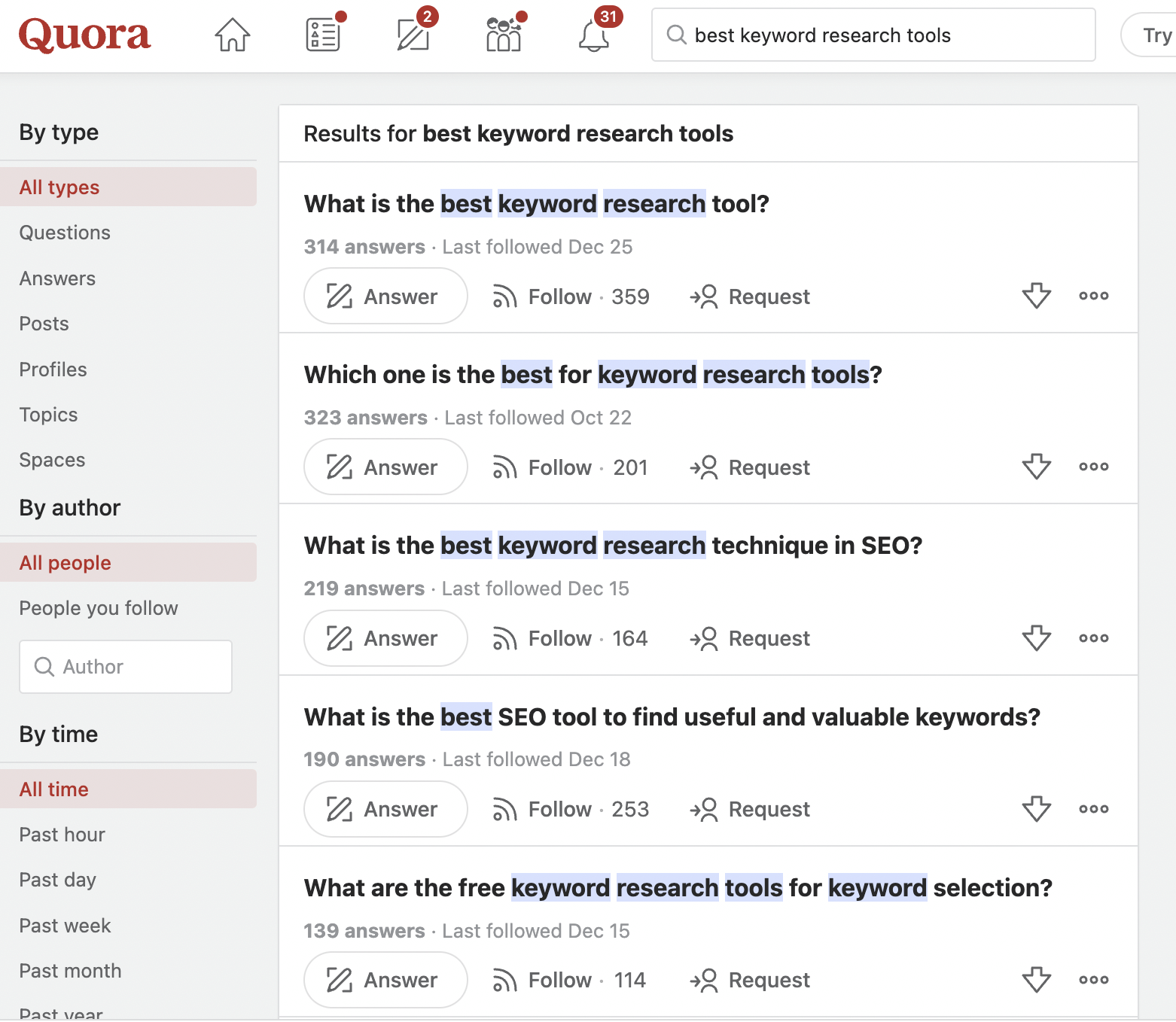
Quora offers you keyword suggestions even before giving results on the search term. You can get an idea of what your target audience is searching for via these auto-suggested keyword suggestions. Here is a screenshot that displays the auto-suggested keywords by Quora:

The keywords Quora suggests may not have a high search volume on Google and other leading search engines, but they are still worth it for your target audience.
When searching for low-search volume keyword suggestions, you should not limit your search to a couple of communities. You can still find some keywords from other websites with user-generated content.
For example, eBay and Amazon have a lot of user-generated content you can go through for keyword ideas.
5- Employ trend analysis tools
Another way to find low-search volume keywords for your SEO content strategy is by using trend analysis tools.
Use tools like Pinterest Trends, Google Trends, and Snapchat Trends to find topics that are trending and might have a low average search volume.
For example, you can filter Pinterest trends based on interests, keywords, gender, and age. You can even filter the trends based on a specific date range.
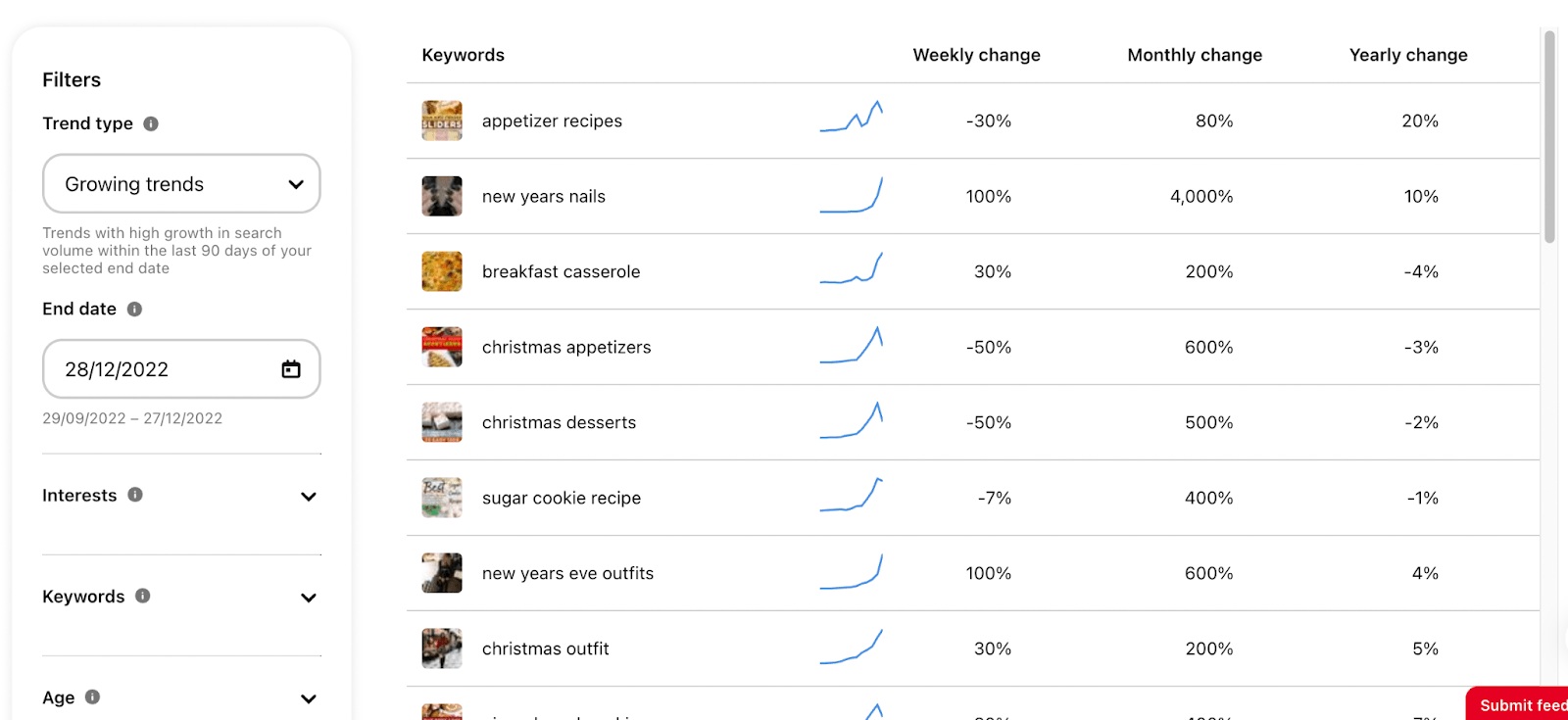
Similarly, you can use Google Trends to discover the latest trending searches in a certain location and in a specific time frame.

However, in the long run, these trendy keywords have the best chances of acquiring traffic to your site.
6- Dig for information on reports, surveys, and journals
You can also find low-search volume keywords in journals, surveys, and reports in your industry.
There is a lot of information available in online publications that you can use to your advantage.
You can find relevant topics on trending articles published on PubMed and the most cited article in SAGE journal. You can also go through some of the research reports on IBISWorld for keyword ideas.
How to Use Low-Search Volume Keywords for SEO
Using low search volume keywords for improving SEO has worked for most new websites looking for a position on SERPs. Here is how you can implement the strategy for your website:
Step 1- Research all useful low-search volume keywords
When researching low-search volume keywords for your target niche, you should begin with the top-of-funnel keywords. You can then focus on keywords on the other segments of a buyer persona. This way, you will not miss out on long-tail keywords that focus on user intent.
Bring your marketing and sales team together. You want them to clarify your ideal buyer persona. Map out the customer journey, and list their pain points and desired outcomes.
When your buyer personas are ready, you should do keyword research to establish what your target audience is searching for online.
Step 2- Create a content plan
After defining the buyer persona and doing keyword research, the next step is to create a content plan.
You should map all the keywords into a clear content plan for your website.
Before you create a content plan, you should have done enough keyword research so that your content is based on your target keywords.
One of the best tricks when creating a content plan is to focus on the overall traffic potential the keyword has.
Tools like Ahrefs can show you exactly how much traffic potential a keyword has. You can shortlist keywords that have low search volume but higher traffic potential to generate the best results.
Thereafter, you can create a content calendar for the next quarter. Your content calendar should have the topic, the word count for the topic based on extensive competitor research, instructions for the writer, the target primary keyword, some secondary keywords, a list of LSI keywords to use within the content, the channels where the content will be published, and the timeline to publish them.
Moreover, your content plan should also include content updation because often, content pieces that are not updated lose their rankings over time. Therefore, you should have a strategy for proper content refreshes after a certain period of time to maintain the accuracy of information.
When you create a powerful content strategy having a set timeline to publish content, you move ahead with a proper plan which is bound to give you the best results.
Step 3- Create quality content for your target audience
Once you have the keywords and a content plan, you should focus on creating content for your audience. At this point, you should implement all the relevant SEO best practices when creating the content.
When you create the content, you should focus more on the keywords at the bottom of the funnel. Cover all the topics that your target audience is searching for. This way, you can get your desired ROI quickly, allowing you to invest more resources into marketing your business.
Here are some top tips for creating quality content for your website:
- Create comprehensive content (between 2100 and 2400 words) because lengthy content has the best chance of ranking higher in the search results.
- Insert keywords in your content naturally to improve the relevance score of your content.
- Create more engaging content that outranks your current competitors.
- Ensure your content and website are navigable for users. Google focuses more on UX when ranking websites.
- Perform competitors analysis and look at the top-ranking content on SERPs. It gives you an idea of how your content should look before you can post.
- Add clear CTAs to your content to improve interaction.
- Make your content entertaining and informative by adding visuals, infographics, and tables.
- Create original, relevant, accurate, and action-oriented content. This will help you stand out with your content and get a competitive advantage.
- Use proper content formatting for easier readability. People don’t read every word in your content, but rather they tend to read the headings, subheadings, and bullet lists. If you intelligently break down your content into proper headings, subheadings, lists, and small blocks of text, this becomes easier to digest.
- Add lots of screenshots, images, infographics, charts, videos, gifs, and memes wherever possible. People love to read text that has lots of images because people understand visuals faster, and an average person responds far better to visual information compared to plain text.
Step 4- Use high search volume keywords once your site begins to rank
When your website begins to pick the SEO momentum and begins to rank, you can now focus on integrating high search volume keywords in your content.
Create content with keywords that don’t just focus on purchase intent but are informative. At this point, you want to focus on keeping your audience coming for more content.
When users land on your website for the first time, they are not likely to buy anything.
However, with time, you can nurture them and bring them toward the end of your sales funnel.
Customers who interact more with your brand are more likely to buy your products and services.
Top Benefits of Targeting Low-Search Volume Keywords
Here are the advantages of targeting low-search volume keywords on your website:
1- Has low competition
Most digital marketers are not focusing on low search-volume keywords because they believe nobody is looking for them on Google. That means there is low competition for these keywords, and you can easily rank your website when you use them on your website.
When a keyword has low search difficulty, it means you can easily rank for the search term. So, if you are launching a website and want to find your way into the first search results page, you should not hesitate to add zero-rated keywords to your content.
2- Helps you focus on the target audience
The other pro of using low-search volume keywords in your content is that it helps you target the right audience.
In most cases, low search volume keywords are hyper-focused. They are more relevant to a target audience. When users enter the keyword on search engines, they are more specific about what they are looking for, and you can easily convert them to buyers.
Most low search volume keywords lack relevant and quality content that answers them. Therefore, you can leverage this opportunity to respond to the questions your prospective customers are asking and become an authority in your niche.
Competitor information can also help you find out what your content is missing.
Low search keywords will help you target a specific market segment in your industry and generate a flow of regular leads for your business.
3- Drives relevant organic traffic to the site
Sometimes when your website is already ranking at the top for high-search volume keywords, you may not think of creating content for low-search volume keywords.
Let me share a stat with you. Around 15% of questions that people ask on Google are new. This means you are not reaching out to 15% of your potential traffic if you don’t focus on low-search volume keywords.
Focusing on keywords with low search volume means most of your visitors will be those coming from long-tail queries. It also means your website will rank high on voice searches.
You can generate more organic clicks and quality leads when you focus on long-tail search terms than when you target low-volume searches.
4- Improves domain authority
In most cases, keywords may have a low search volume because people are yet to use the terms or are not using them more frequently.
Now, because your target audience is not using the search term to find your business does not mean you should not use the keywords.
If you are in a small niche, you can focus on keywords with low search volume to build site authority.
You will likely be the only one with answers to these low-search keywords. Create a keyword strategy and get a headstart to create more relevant keywords with high search volume over time. This will help your site to become an established authority in your niche.
5- Offers a higher ROI
When you target low-search volume keywords based on specific long-tail searches, you drive traffic that is niche-specific.
Even though the amount of traffic you get via low-volume keywords is less, the chances of conversion they offer are more compared to short-tail high-volume keywords.
Therefore, low search volume keywords offer a higher return on your content investment.
An ideal SEO strategy should have a proper mix of long-tail and short-tail keywords.
Final Thoughts
Focusing on the right keywords is a common strategy to rank higher on search results. However, this strategy requires skills, with trial and error.
If you find it hard to rank on high search volume keywords, you can change to low search volume keywords and reach out to the target audience.
Low search keywords are underrated when it comes to ranking. You can tap into the power of low-volume keywords to rank faster and get results.
